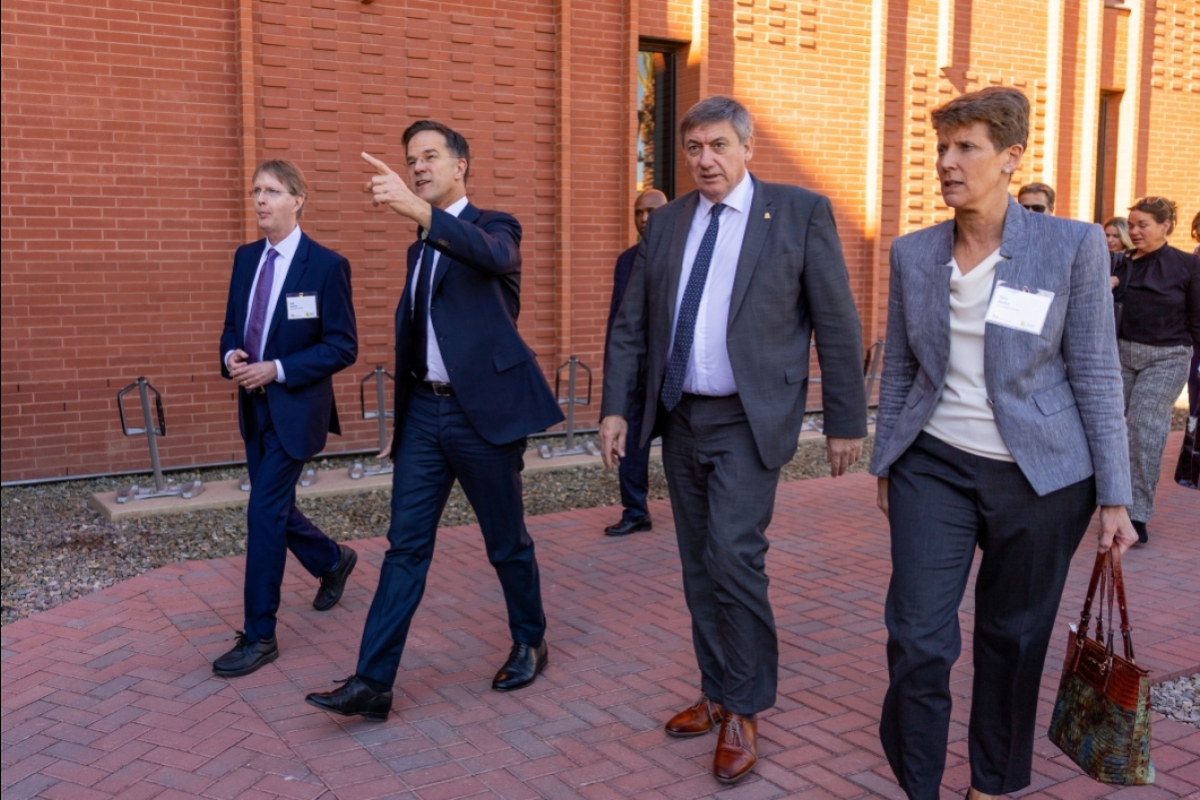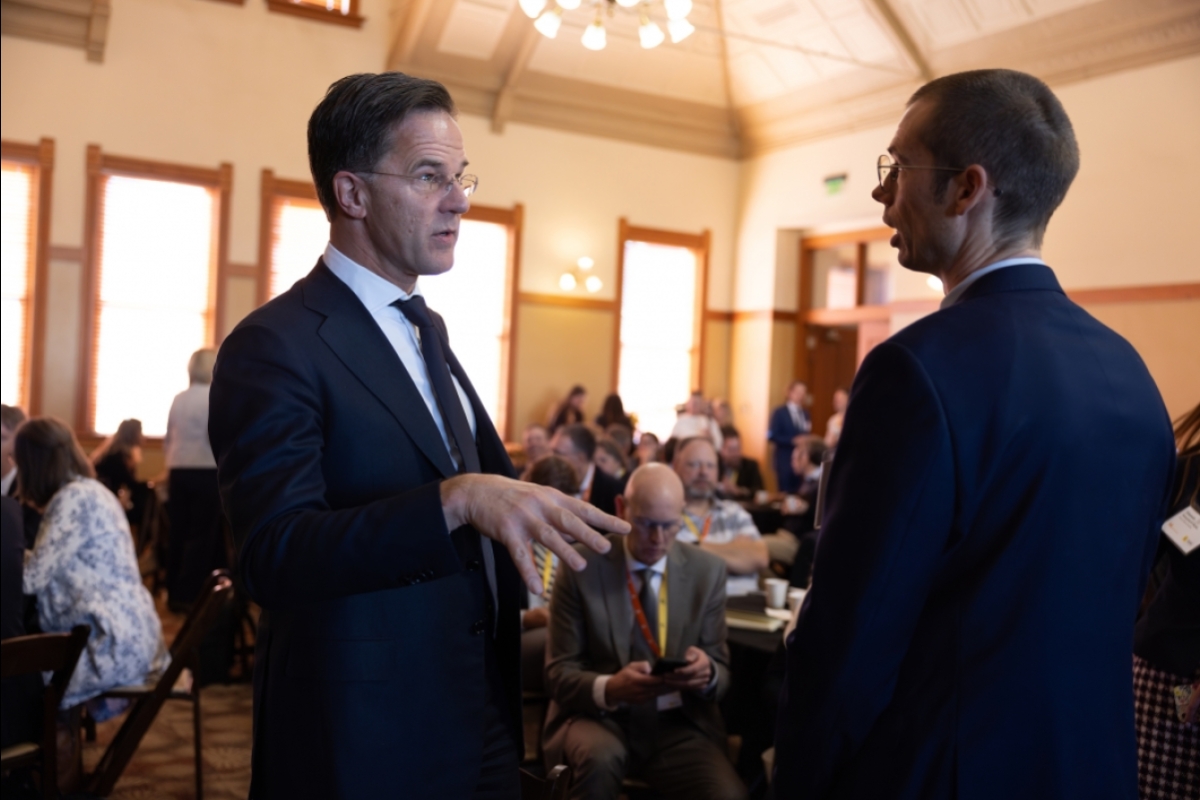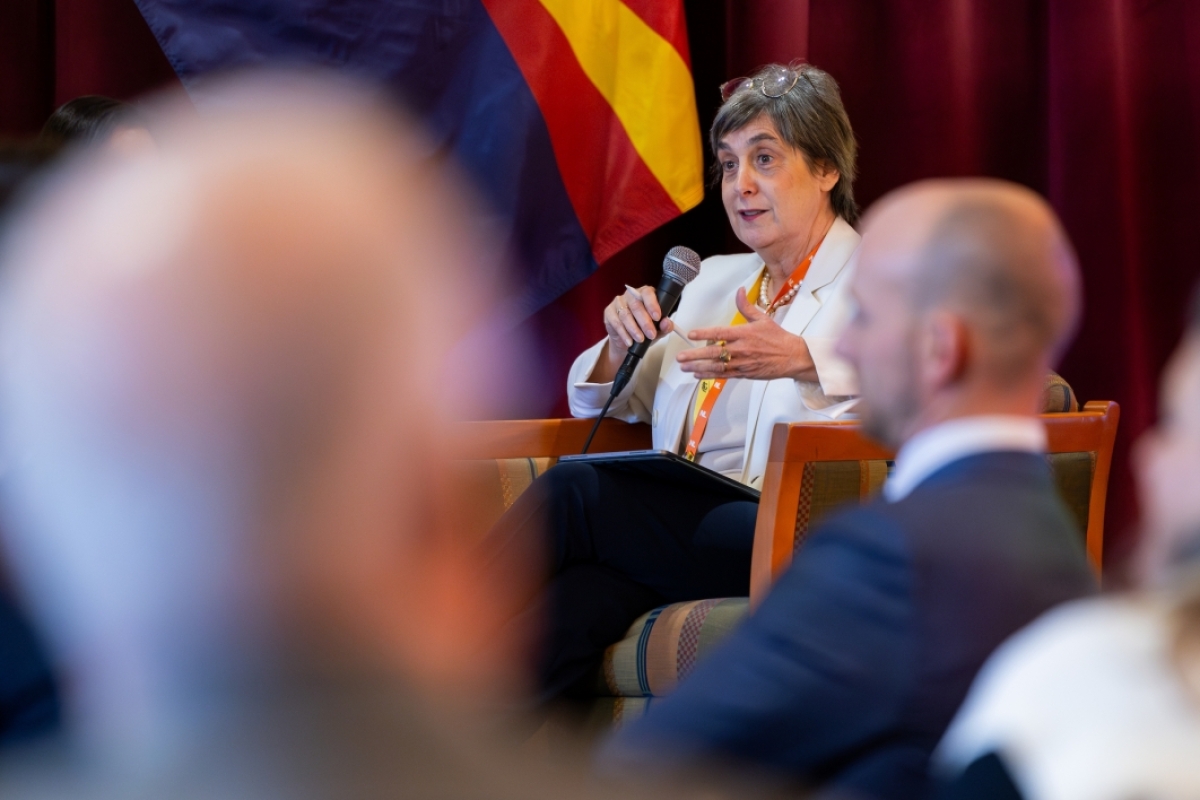Dutch, Flemish delegations visit ASU, tour lab and fabrication space
Dutch prime minister says innovation key to solving problems like climate change

(From left) Ira A. Fulton Schools of Engineering Vice Dean of Research and Innovation Zachary Holman, Netherlands Prime Minister Mark Rutte, Flanders Minister-President Jan Jambon and Executive Vice President of Knowledge Enterprise Sally Morton participate in a panel discussion during the Netherlands and Flanders delegation visit to ASU’s Tempe campus on Dec. 5. Photo by Samantha Chow/Arizona State University
Editor’s note: This story is featured in the 2023 year in review.
The 50 semiconductor and manufacturing company representatives from the Netherlands and Flanders (the Dutch-speaking northern portion of Belgium) saw a familiar scenario being played out when they visited Arizona State University’s MacroTechnology Works facility in Tempe on Tuesday.
MacroTechnology Works, a lab and fabrication space unique to the microchip research and development space, provides an environment where the public and private sectors come together, a model that national and local public policymakers are looking to as a framework for how to advance the industry domestically through CHIPS investment.
“In the Netherlands, we work a lot with the model we call triple helix,” said Agnes Kopplemann, deputy head of mission for the Netherlands consulate in San Francisco. “It’s universities, it’s entrepreneurship and it’s governments. They’re all working together to stimulate innovation. And we see ASU is doing that as well.”
That shared vision is why Mark Rutte, the Netherlands prime minister, and Jan Jambon, minister-president of Flanders, chose to visit ASU on Tuesday as part of the delegation to the United States, their visit headlined as an “economic mission on semiconductors.”
“This is a global industry,” said Kyle Squires, dean of ASU’s Ira A. Fulton Schools of Engineering. “We cannot be successful in meeting our goals if you are not successful in meeting yours. That’s a fact.
“So the fact that we have like-minded individuals gathering around the table to really understand what is state of the art, how do we think about that and how do we move forward is exciting.”
ASU’s Microelectronics Industry Council, which includes Dutch semiconductor companies ASM and ASML, enables leadership, advocacy and collaboration among diverse high-tech enterprises, including multiple microelectronics industry leaders.
Sally Morton, executive vice president of ASU’s Knowledge Enterprise, said cooperation between countries and, locally, between academic institutions like ASU and private companies is essential.
“We’re excited to host you and find ways to grow the partnerships between our two critical global semiconductor clusters,” Morton said as Rutte, Jambon and the company representatives gathered at Old Main Tuesday afternoon.
“Each of these challenges is too big for one company. They’re too big for one university, and I think they’re too big for one country. For that reason, we are incredibly fortunate to be working with close allies from the Netherlands and Flanders building on our shared values. We can grow the durable partnerships needed to tackle these really generational challenges related to semiconductor innovation, talent and sustainability.”
In their remarks, Rutte and Jambon stressed the need for the semiconductor industry to attract young talent by pointing out that innovation and technology are key to solving future health issues like climate change.
“A lot of young people are now on the streets, asking for measures that we can take for the climate challenge,” Jambon said. “We have to convince these people that if they really want to contribute to the solution, innovation (is the way).”
Morton said an inclusive approach is needed in order to attract young semiconductor workers to a field that, according to the U.S. consulting firm Deloitte, will require more than 1 million additional workers by 2030.
“They want to change the world,” Morton added. “We have to show them why this industry is so central to the future of the world. … Some of them are pragmatic about economic development, but I also hear dreams. I hear about setting forth a strong future for our children through sustainability. I think it’s those common goals and dreams that tie us together.”
As he gave a tour of MacroTechnology Works, Zak Holman, vice dean for research and innovation at ASU’s Ira A. Fulton Schools of Engineering, explained to representatives of the Dutch semiconductor industry how ASU is innovating the semiconductor space.
In order to bridge what Morton called the “lab-to-fab (fabrication) gap,” ASU leases space in the 250,000-square-foot MacroTechnology building — which includes 43,000 square feet of clean room space — to companies, and through research partnerships with ASU, they can collaborate with faculty and students to accelerate semiconductor, advanced materials and energy device research.
“We’ve recognized the lab-to-fab gaps that that exist in the U.S.,” Squires said. “It’s a gap in capabilities. It’s a gap in tools, equipment and personnel. It’s a gap in access for researchers. That gap has blocked innovation.
“Across the college of engineering and Dr. Morton’s office, we began to think very generatively about what it would take to really move the needle when it comes to genuine, long-lasting innovation.”
Holman told the group of Dutch businessmen that ASU makes no money leasing space. Instead, he said, the university only covers its cost. Typically, he added, there’s a one-to-one, dollar-to-dollar match when it comes to the research partnerships. For example, if a company is leasing 500,000 square feet of clean room space a year, it’s also sponsoring $500,000 of research with ASU.
“At least in the U.S., it’s very strange for a university to have a facility like this,” Holman said. “As you know, the path from successful prototyping to high-volume manufacturing is an enormous gap. The idea is, we can put something in the middle that has flexibility at scale.”
Françoise Chombar, chairwoman and co-founder of Melexis, a Dutch company that is a global supplier of microelectronic semiconductor solutions, said the opportunity to see what ASU is doing in the field could lead to research partnerships between the university and Dutch companies.
“I see enormous potential of learning and the exchange of ideas between the two ecosystems,” she said.
More Science and technology

Associate professor shares her journey from NASA to ASU
From leading space missions to designing and building spaceflight hardware and training students in space science and engineering, Arizona State University is proving that space is more than a…

Famed systems engineer inspires ASU to tackle global problems
“Providing great talent with great opportunity can make a great difference.” Such was a key part of the message delivered by G. Don Taylor, executive vice provost and the Charles O. Gordon Professor…

The science behind chronic stress
Stress comes in many shapes and sizes. There’s the everyday stress of preparing for a final exam or being stuck in traffic. And the more significant stress of losing a friend, family member,…




